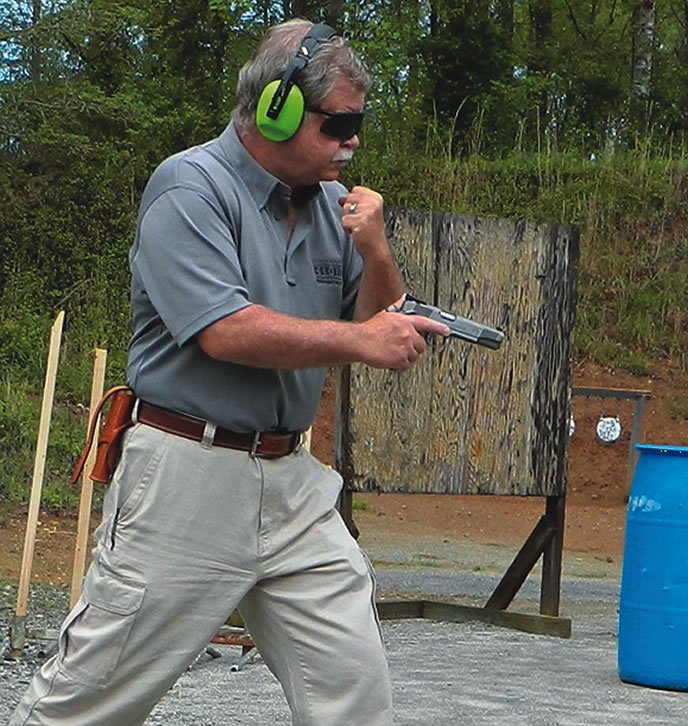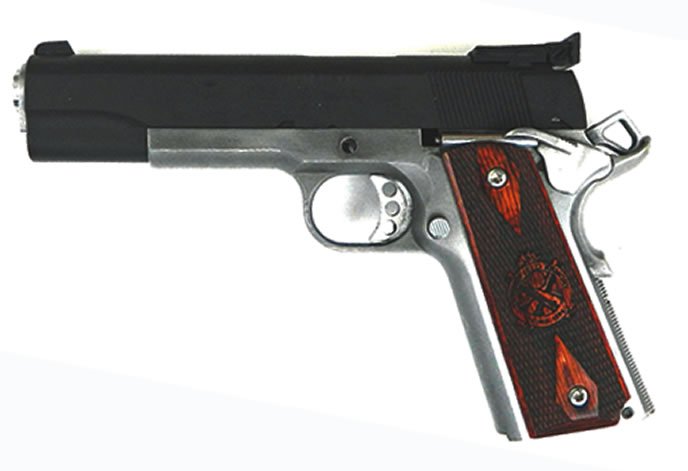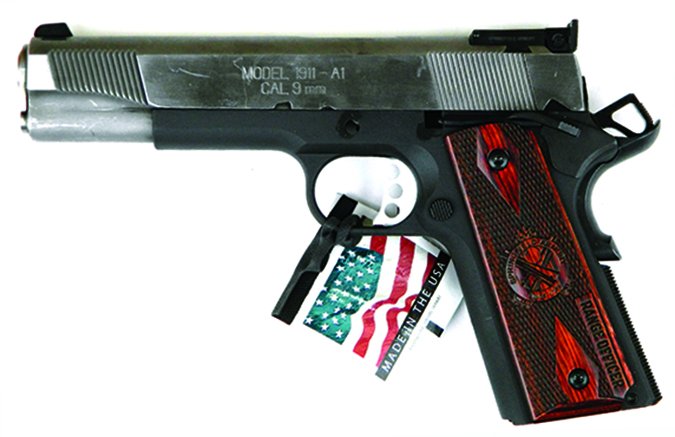There are many good reasons for purchasing a 1911 in the non-traditional 9mm Luger cartridge. Compared to 45 ACP, 38 Super, and 10mm, 9mm Luger ammunition is less expensive and easy to come by. Also, the 9mm is only improved when fired from the 1911, with that platform’s solid ergonomics, reliability, and distinctive appearance. In a 1911, the 9mm is easy to shoot well, despite a history in which 9mm target guns were seldom as accurate as a properly set up 45. As it turns out, the 9mm 1911 with modern ammunition is plenty accurate. Some shooters might also worry that 9mm 1911s might be less reliable, but we can only say that in our small sample of hundreds of rounds, two tested 1911 9mm handguns were reliable.

Where do such guns fit in? For one, the 9mm 1911 is a great target and competition handgun. Just as a cowboy-action shooter may choose a 38 Special SAA for economy and low recoil, an IDPA shooter may find the 9mm affords economical practice without creating waves in the arm from recoil. The self-defense shooter need not worry either, because with +P loads, the 9mm is no slouch in the wound-ballistics department.
We have had calls to choose between two closely matched stablemates from Springfield Armory, and both the Loaded Target PI9134LP and the Range Officer PI9129LP are traditional full-size 9mm pistols. This simply means that they are based upon the 45 ACP’s frame. They are very similar to 38 Super pistols, save for a breech face of 0.384 versus 0.405 inch for the 38 Super. By changing a barrel and opening the breech face, the 9mm pistol may be converted to 38 Super. As you may imagine, converting a 38 Super to 9mm is a bit easier since the larger breechface usually works okay with both cartridges. (Exceptions: The Para USA LDA 9 and the Springfield EMP 9mm are 9mm pistols that are a bit smaller in dimension than the full-size Springfield pistols. They cannot be converted to the 38 Super.)

The full-size 9mm handguns are designed to fill a niche for those favoring the 9mm, or those simply wishing to own a lighter-kicking 1911 than one chambered in 45 ACP or 40 S&W.
The 9mm Range Officer has the same forged national match frame and slide as the Trophy Match and TRP 1911s. It gets the same precision fit as those more expensive pistols, Springfield says. Likewise, it uses the same match-grade stainless-steel barrel and bushing and is topped with a fully-adjustable rear target sight. This is a great help to us in adjusting point of aim to point of impact when we’re shooting different bullet weights. It has a single-sided thumb safety.

The Loaded 9mm Stainless Steel has a polished finish on the flat surfaces and bead-blasted matte finish on the rounded areas. The 5-inch barrel is a match-grade stainless steel unit. The slide features slanted serrations on the front and rear, where the RO has only rear cuts. The mainspring housing is flat and includes the company’s integral locking system, or I.L.S., which replaces the mainspring housing of the handgun. When engaged, the I.L.S. prevents the hammer from moving by locking the mainspring cap, making the gun inoperable. Elsewhere, the pistol has a lightweight Delta hammer and a beavertail grip safety with raised memory pad for positive engagement. The extended thumb safety is ambidextrous, and its long aluminum match-grade trigger separate it from the RO. The pistol is fitted with a two-piece full-length guide rod. The grips are held in place with Torx grip screws that look nice and distinguish it from the RO.
During the evaluation, both handguns were field stripped. Interestingly, the Range Officer slide easily slipped on the Loaded Model Frame. The Loaded Model slide, however, was too tight on the Range Officer frame to function. Since modern 1911 handguns are not disassembled and thrown into a barrel on Guadalcanal for cleaning, then assembled regardless of original set up, this is acceptable and also interesting. The Range Officer seemed to have the tighter barrel bushing lockup. The barrel was a tight fit overall. We were surprised that the barrel bushing was only finger tight with the Range Officer.
But what matters is the shooting, and what our team found is that these 1911s chambered in 9mm Luger make for a very pleasurable shooting experience. An accurate 1911 in 9mm is even more enjoyable. Here’s more of what we learned about them when firing them side by side:

Springfield Armory 1911 Range Officer PI9129LP 9mm Luger, $704
The price shown is what this SKU listed for at BudsGunShop.com. The Springfield Range Officer, in our opinion, is among the best buys in a 1911 handgun. We established this in previous testing of the 45 ACP model. The pistol is designed to offer target-grade accuracy at an entry-level price. Compared to the Loaded Target at $873 from the same retailer, the savings are significant. You would be able to purchase a lot of 9mm ball for practice with the money saved.
The finish of the Range Officer is the same Parkerized or matte finish applied to the Springfield Mil Spec and the Springfield GI 1911A1. The pistol arrived in a foam-lined hard case with the usual manuals and promotional items, as well as a spare magazine, cleaning rod, and range holster and double magazine pouch. These are useful implements and a big plus; you do not have to buy a range holster. In our view, the provided holster isn’t professional grade for carry, but it is useful. They are well made for plastic and have adjustable tension.
The Range Officer features a forged frame and slide. The barrel, barrel bushing, and link are stainless steel. The trigger bow is stainless steel, while the trigger face is aluminum. Our gun’s trigger action was smooth, with little creep, and a break weight of 7 pounds. This is nearly 2 pounds heavier than the 45 ACP version previously tested.

The pistol’s front strap was smooth, in common with the Loaded model, while the checkered mainspring housing offers a degree of abrasion. Coupled with attractive rosewood grips, our shooters said the pistol offered a sure grip when it was being fired. (The grips are described by the company as cocobolo, but they do not feature the distinctive black piping or streaks found in true cocobolo, we believe.)
The skeletonized hammer was nicely serrated. This is fine for lowering the hammer; however, the rear sight would interfere with thumb cocking, we think. Our shooters would prefer to carry the pistol properly cocked and locked as a result.
The pistol was visually identical to the Springfield Range Officer 45, save for the size of the hole in the barrel and the 9mm markings. The slide, barrel, extractor, and other parts are tailored to the 9mm. An important point is that the 9mm barrel is a ramped design. The traditional 45 and most 38 Super and 9mm handguns feature a two-piece feed ramp with the requisite 1⁄32-inch gap between the two parts of the feed ramp. The ramped barrel supports the case head in a superior manner. Feed reliability should be better with this design. The tolerances may even lend themselves to simpler manufacture. This design, one of the raters noticed, seems to impart a more robust lower locking lug. The consensus was that the ramped barrel is a good thing. Quite possibly, there may be no stronger 9mm handgun for the enthusiastic handloader. One of the raters noted that his LW Loaded Model 45 with ramped barrel has passed the 20,000-round mark without a problem. So we give this feature a hearty thumbs-up.
The sights were identical between the two handguns. The front post appeared to be a Novak, with a solid dovetail installation. The front posts were identical, with excellent fit into the slide. The rear sights were adjustable for windage and elevation. During the test, we used a lot of different bullet weights that proved interesting. Without adjustable sights, there is simply no means of achieving the perfect zero. More important, these handguns proved accurate enough that the perfect zero is useful, say for competition or even for small-game hunting. In our experience, there are few personal-defense handguns likely to be as accurate as these two. When firing 9mm Luger loads in variations of 92 grains to 147 grains, the divergence in the point of impact with the same sight picture could be as much as 4.5 inches. (We fired Fiocchi 92-grain Mono Block hollowpoint and Fiocchi 147-grain JHPs to see what the divergence in point of impact was at 25 yards.) Velocity ranged from almost 1400 fps to 900 fps. In each case we were able to adjust the sights to the correct height for precise shooting with every bullet weight. The same applied to the Loaded Target Model’s sights.
Each pistol is a true Series 70 type without a firing-pin block or drop safety. Instead, drop safety is attained by use of a lightweight firing pin and heavy firing-pin spring.
The final test before actually shooting them for accuracy was dry-firing, with attention to the trigger action. The wide beavertail felt good during this drill, with a speed bump that helps funnel the hand into the frame. The RO’s grip safety released its grip on the trigger about halfway into the safety’s travel, about where we expected it to disengage.
The pistols were lubricated for range work and the magazines loaded. Like many of you, we have partial boxes of 9mm left over from range tests. We carefully catalog what is used and split the loads between test guns. In this case, we had on hand a good supply of diverse ammunition. We fired 140 rounds in each Springfield of a mix of Fiocchi 115-grain Extrema, Fiocchi 124-grain JHP, HPR 124-grain JHP, and Winchester 115-grain USA. Each handgun came out of the box running. Initial firing was taken in running combat courses at 7, 10, and 15 yards.
The pistols were drawn from strong-side belt holsters from Nelson Holsters (NelsonHolsters.com) and Rocking K Saddlery. (RockingKsaddlery.com) These are excellent leather holsters, one for concealed carry and one for Wild Bunch competition. Leather was chosen partly to preserve the finish of the Range Officer and partly because these holsters exhibit a good balance of speed and retention. In working the pistols through fast drills, the superior trigger action of the Loaded Model seemed to give slightly better results in combat shooting.
After the combat shooting drill, a few targets were fired off the barricade to test for divergence of point of aim and point of impact with the 92- and 147-grain loads, but no great effort was made to record accuracy. At this point we broke the 300-round mark in each pistol without any type of malfunction. None of the loads fired at this point were +P loads, but we used a +P for accuracy testing. There were no malfunctions in the Range Officer or Loaded Target pistol.
The Range Officer was cleaned and prepared for accuracy testing. We used three loads, a previous favorite for personal defense, Fiocchi’s 124-grain XTP. A plus-pressure choice was Black Hills Ammunition 124-grain JHP +P. The heavyweight load was Hornady’s 147-grain XTP. These loads, fired from a solid bench rest at 25 yards, proved to be consistent and accurate in both pistols. The most accurate group was fired with the Hornady XTP in the RO, a 1.3-inch cluster. Also, the Range Officer never failed to feed, chamber, fire, or eject.
Springfield Armory Loaded Target PI9134LP 9mm Luger, $873
This was the price from Bud’s Gun Shop at the time of the test. The Springfield Loaded Model Target is a logical extension of the successful Loaded Model line. The pistol was well fitted, well finished, and overall was an attractive handgun. Much that is said of the fitting of the Range Officer applies to the Loaded Model, but there were differences. The barrel fit of the Range Officer appeared tighter, but this is difficult to quantify between good, tight 1911 handguns. For an additional $169 dollars in the Loaded Model, you get forward cocking serrations, a full-length guide rod, stainless-steel construction, and an ambidextrous safety. The shelf of the standard Range Officer slide lock safety and the Loaded Model were identical, we noted. The right-hand lever (for left-handed shooters) of the Loaded Model safety was well designed and supported by the stocks, we saw.
To our eyes, the biggest advantage of the Loaded Target was its stainless-steel construction, an obvious plus for a hard-use pistol to be worn in all types of weather. The full-length guide rod (FLGR) is sometimes criticized as adding to the complexity of field stripping. However, the FLGR also prevents the pistol from going out of battery when jammed against the barricade and may be an aid when firing heavy loads.

Range gear and appointments with the Loaded Model mimic the Range Officer’s. When the sum of the advantages of the Loaded Model are added up, it seemed to us that it was a pistol better suited for tactical use. The forward cocking serrations, full-length guide rod, and stainless-steel construction are good to have. The ambidextrous safety is a help to allow use of the handgun by either hand. A left-handed shooter would prefer the set up even more.
During the initial range evaluation, the Loaded Model fired the same mix of ammunition as the Range Officer, 40 Fiocchi 115-grain Extrema rounds, 35 HPR 124-grain XTPs, 25 Fiocchi 124-grain JHPs, and 40 Winchester 115-grain USA cartridges. There were no failures to feed, chamber, fire, or eject. During testing of sight regulation and the ability of the sights to be zeroed, we also used the Fiocchi 92-grain hollowpoint. All proved reliable, as did the Fiocchi 147-grain XTP. These sights are fully the equal of any we have tested from any maker, including the well-respected Bo-mar sight.
One of the raters also fired some of his favorite personal-defense load, the Hornady 115-grain Critical Defense, and found each pistol reliable with this load. He loaded the Loaded Model, put it in the Nelson holster, and carried it on his long trip home. One of the raters, a big fan of the 9mm +P and 9mm +P+, noted we had neglected the hot loads during our test. So he fired rounds from his personal cache in each pistol, including the Winchester 124-grain +P, the Winchester 127-grain +P+, and the Hornady 135-grain Flex Lock. The pistols remained reliable, and he noted control was excellent.
When firing in the offhand range drills, combat shooting and during tactical movement, the pistols were basically equal. All raters, in fact, enjoyed these handguns more than practically any other we have tested. They simply run well and do not offer recoil sufficient to produce pain in the arm. Even the dedicated 45 ACP shooters admitted the 9mm is much easier to use well.
While much was equal between the handguns, the lighter trigger compression of the Loaded Model was deemed an advantage. When we moved to the bench firing, we expected the trigger compression to give the Loaded Model an advantage. However, as it turned out, the Loaded Model did not deliver the accuracy of the Range Officer. None of the three loads tested gave the same accuracy with the Loaded Model as the Range Officer, although all were accurate. The most accurate loading in the Loaded was again the Hornady 147-grain XTP, with the best effort being a 1.6-inch group.
Our Team Said:In this test, the Range Officer was more accurate by a margin, and it might be even more accurate with a better trigger action. The Range Officer exhibited a tighter lockup, and it might be the handgun a careful handloader could use as a vehicle to produce very tight groups. For the dedicated target shooter, we think the Range Officer is the better choice. For the tactical shooter, the practical advantages of the stainless Loaded Target make it a better buy. But the truth is, you can’t go wrong either way.
Written and photographed by R.K. Campbell, using evaluations fromGun Teststeam testers.


























